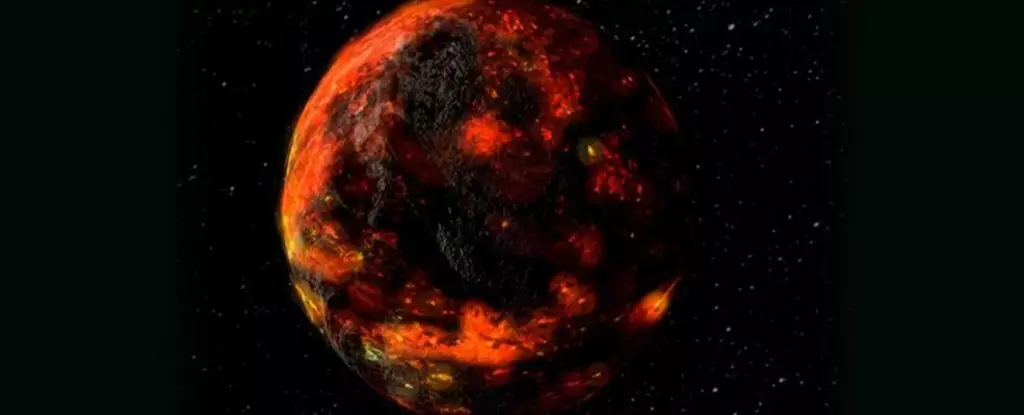The Moon, our enigmatic neighbor, has captivated scientists and dreamers alike since time immemorial. Despite the extensive knowledge obtained from various lunar missions, particularly the historic Apollo missions, the intricate details surrounding the Moon’s early formation remain a subject of active research. Recent investigations, spearheaded by a team at the University of Chicago, have provided significant insights into the Moon’s primordial history, offering a glimpse into its development during the early epochs of our Solar System.
Recent studies have revealed that the Moon crystallized approximately 4.43 billion years ago, coinciding with a key phase in Earth’s transformation into a life-sustaining environment. Led by scientist Nicolas Dauphas, this groundbreaking research leveraged precise measurements of the isotopic ratios in lunar rocks collected during the Apollo missions. By analyzing the elements within these samples, researchers gained invaluable information about the Moon’s early state, particularly the formation of its distinctive KREEP (potassium, rare earth elements, and phosphorus) layer.
The discovery of KREEP is not merely a geological curiosity; it is crucial for understanding the Moon’s formation process. Following a cataclysmic collision between a Mars-sized body known as Theia and the early Earth, the debris from this event coalesced into the Moon. Initially, this nascent Moon existed as a molten mass slowly cooling over eons. The transition from a molten state to solid rock involved the differentiation of materials, leading to the formation of layers that now provide insight into both the Moon’s geological history and the broader dynamics of the early Solar System.
KREEP represents a residual component of the now solidified lunar magma ocean, serving as a relic from the Moon’s formation. Researchers established that KREEP began forming about 140 million years post-Solar System birth. This timeline is particularly enlightening as it links the Moon’s crystallization to significant astronomical events occurring during its development. Studying the KREEP layer offers a closer examination of the Moon’s cooling timeline and the impact it has on the comprehension of planetary processes at large.
Dauphas’ work involved meticulously comparing the proportions of lutetium and hafnium isotopes within lunar samples, thereby creating a more defined chronological framework for KREEP’s appearance. This isotopic analysis revealed that while many Solar System bodies contained relatively uniform amounts of lutetium, the Moon’s unique conditions led to its distinctive distribution. Such disparities in isotopic ratios provide a foothold for understanding the nuanced evolutionary paths of celestial bodies in our neighborhood.
Intriguingly, while the Moon’s magma ocean was crystallizing, it continued to endure bombardment from leftover planetesimals and planetary embryos from the Solar System’s chaotic beginnings. This violent period of impacts played a pivotal role in shaping both the Moon’s surface and its geological features. The haywire of impacts initiated the lunar mare, dark basaltic plains resulting from volcanic activity triggered by the collisions.
The current understanding posits that the Moon not only originated from the debris of Theia but also was significantly influenced by continuous impact events, contributing to the extensive volcanic activity that followed. Scientists assert that impacts from celestial debris were instrumental in generating lava flows capable of filling vast craters and flattening portions of the surface.
The implications of lunar studies extend beyond our Moon’s history into understanding Earth’s evolution. The colossal impact that led to the Moon’s formation may well represent the last significant geological event on Earth, marking a transformational period toward a more stable planet, conducive to life. The chronological link between the Moon’s cooling phases and the evolution of Earth invites ongoing exploration into how celestial events shape planetary development and stability.
The research led by Dauphas and his team not only illuminates aspects of the Moon’s geological past but also enhances preparations for future missions such as Artemis and Chang’e. These missions aim to retrieve more lunar samples, especially from the South Pole-Aitken basin, promising to better elucidate the history of KREEP and its implications. Such undertakings will undoubtedly enrich our comprehension of planetary formation, solidifying the Moon’s role as a critical player in the story of our cosmic neighborhood.
The quest to unravel our Moon’s history continues to yield intriguing revelations that reshape our understanding of celestial interactions in the early Solar System. The findings underscore the importance of enduring geological evidence in piecing together the grand narrative of lunar and terrestrial evolution, fostering a deeper appreciation of the cosmic dance that links our Earth, Moon, and the broader universe.


Leave a Reply